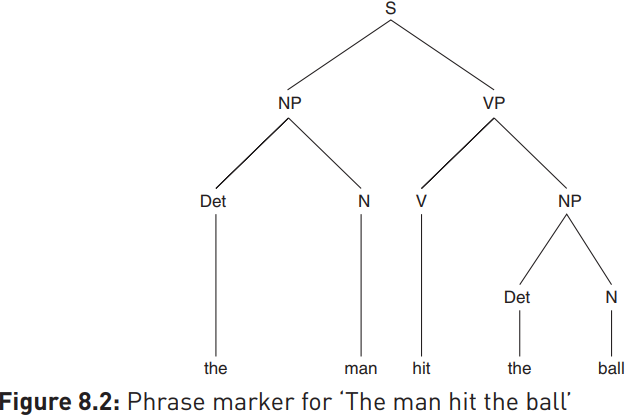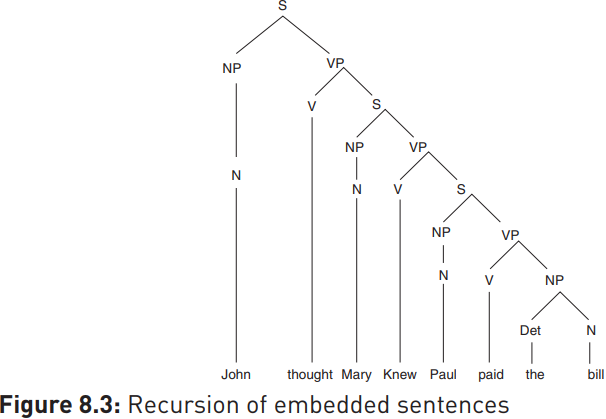
The evolution of generative grammar
 المؤلف:
David Hornsby
المؤلف:
David Hornsby
 المصدر:
Linguistics A complete introduction
المصدر:
Linguistics A complete introduction
 الجزء والصفحة:
162-8
الجزء والصفحة:
162-8
 2023-12-25
2023-12-25
 1961
1961
The evolution of generative grammar
Unlike the Descriptivists, who built their grammars ‘upwards’ from phonemes to sentences, Chomsky put syntax at the centre of his formal model, providing rules to generate well-formed sequences from abstract syntactic units. The essential components of a sentence (S) of traditional grammar, namely subject and predicate, were reframed in these terms as NP and VP:
S →NP VP
These two constituents might then be rewritten as follows:
NP → (Det) (Adj) N
VP → V (NP)
In this rule notation, the bracketed items are optional but the non-bracketed ones are not: a noun phrase and a verb phrase must be headed by a noun and a verb respectively. Our simple NP rewrite rule generates such phrases as the old man, this house and girls, and our sentence rule generates a very large number of sentences, including Chomsky’s own example from Syntactic Structures:
The man hit the ball.
which we can present either as a labelled bracket structure S [ NP[ Det[The] N[Man]] VP[V[hit] NP [Det[the] N[ball]] or, more commonly, for ease of exposition, as a tree diagram:

To generate an infinite number of grammatical sentences from finite means, the model has to allow for recursion, which is achieved by allowing constituents to occur within constituents of the same kind. In the example below, for example, S recurs as a daughter node of VP:

Recursions of this kind illustrate an important difference between what Chomsky calls competence, an individual’s internalized grammar, and performance, its realization in speech. The capacity to produce infinitely long recursive sentences is a matter of competence, but limits are imposed by real world considerations of performance: overlong sentences are boring and difficult to process, you have a finite amount of breath, and your interlocutor may do you an injury if you do not stop after a reasonable amount of time.
The partial grammar of English above rules out sentences that do not conform to its phrase-structure (PS) rules, for example:
1 *Clever girl the questions answered
2 *Exists house
3 *The brown cat ate yellow
It would, however, require some refinement in order not to generate ungrammatical sentences like the following:
4 This green cats eat a mice
5 John exists a banana
Modifications to the grammar, for example agreement rules in (4) and a specification in the lexicon that exist cannot take an object NP in (5), are easily introduced. But Chomsky draws our attention to a more fundamental problem of phrase-structure grammars, namely that they fail to account for relationships between sentences, for example this active/ passive pair:
1 The cat ate the mouse
2 The mouse was eaten by the cat
The relatedness of the this pair is not evident from their structural description, but Chomsky argues that the passive (7) is derived from the active (6) by what at this stage he calls a transformation, which he sets out thus:
‘If S1 is a grammatical sentence of the form
NP1 – Aux – V – NP2
then the corresponding string of the form
NP2 - Aux + be + en1 – V – by + NP1
is also a grammatical sentence.’
By positing a transformational component allowing constructions in surface structure to be derived from others in deep structure, Chomsky accounts for complex structural ambiguities. In (1) below, for example, the structural ambiguity comes from the different constructions in deep structure (2) and (3) from which (1) is derived:
1 The shooting of the hunters
2 The hunters shot (someone/something)
3 (Someone/something) shot the hunters
Note that, in early models of generative grammar, surface structure is not to be equated with output: the latter is generated from surface structure by the phonological component.
 الاكثر قراءة في Syntax
الاكثر قراءة في Syntax
 اخر الاخبار
اخر الاخبار
اخبار العتبة العباسية المقدسة


